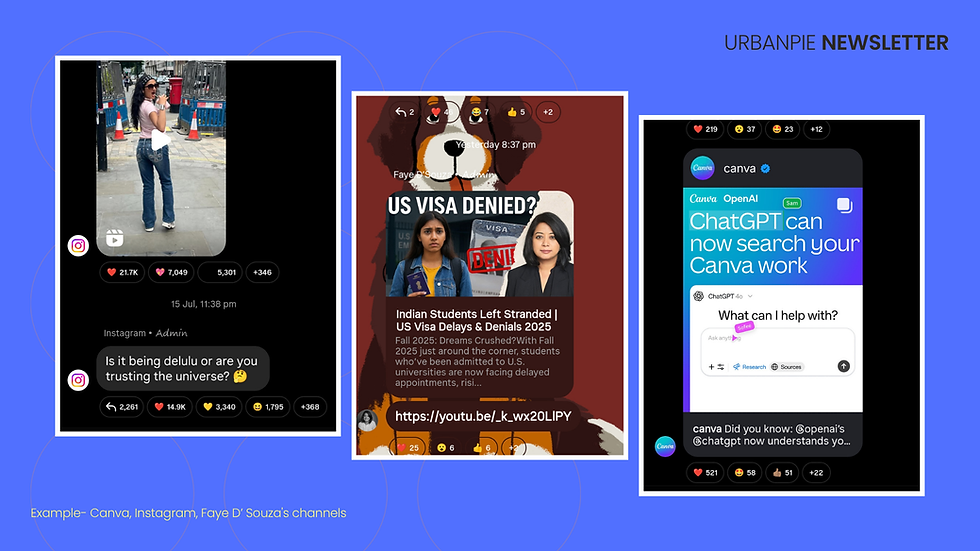The Role of Micro-Interactions in Building Stronger Communities
- Innovate Urban
- Jul 29
- 4 min read
Rethinking Digital Engagement: The Core Problem
In a digital environment dominated by performance metrics, most brands continue to rely on traditional outreach methods—posting content, tracking likes, and hoping for conversions. While these metrics offer visibility, they fail to establish emotional relevance. Engagement, when reduced to numbers, overlooks the essential human factor: connection. Despite growing audience sizes, many platforms report declining quality of interaction—comments remain sparse, DMs go unanswered, and community fatigue sets in. The underlying problem is structural. Brands continue to communicate at users, rather than with them.
Micro-Interactions as Behavioural Infrastructure
To address this gap, micro-interactions have emerged as critical design elements in community strategy. These are small, intentional prompts—such as polls, emoji reactions, short replies, or in-platform acknowledgements—that trigger emotional participation. Backed by neuroscience, including findings by Dr Paul Zak, these moments stimulate oxytocin release, fostering trust and empathy. In digital terms, this translates into repeat engagement, content memory, and brand recall. Unlike static posts, micro-interactions create a sense of presence—offering users a way to respond without friction and be noticed without effort.
Lessons from Practice: How Platforms Are Responding
This model is already being operationalised across several leading platforms. Journalist Faye D’Souza uses Instagram Broadcast Channels to share sensitive news with her 50K+ audience, where reactions serve as real-time sentiment indicators. Her approach transforms viewers into stakeholders by offering space to react to emotionally charged updates—such as aviation accidents or governance issues. Similarly, Instagram itself has tested its own audience with candid polls, asking users about their on-platform behaviour. These self-reflective prompts—seen by nearly half a million viewers—demonstrate how even platform giants can use humility and curiosity to strengthen bonds. Canva has adopted a storytelling approach through its broadcast group, mixing event footage with community shout-outs, reinforcing its image not as a product, but as a partner in user creativity.


Where Communities Are Actually Forming
What unites these examples is not the size of the audience but the structure of the interaction. Community-led platforms such as WhatsApp Communities, Telegram groups, and Instagram Broadcast Channels are replacing traditional feeds. These formats allow for curated, focused communication with built-in feedback loops. Instead of chasing visibility, creators and brands are now designing environments for active co-presence.
Building Engagement: A Structured Approach
To build these communities, a phased framework can be applied.
First, seed a micro-tribe by inviting users into a closed space.
Second, introduce low-effort engagement tools—such as emoji sliders or reaction polls.
Third, humanise brand messaging through founder notes or real-time behind-the-scenes updates.
Fourth, respond directly to users using name mentions and personalised replies.
Finally, promote community ownership by highlighting audience contributions. This structure can be applied across sectors—whether it is media, education, health, or product marketing—and adapted to suit different platform affordances.
From Reach to Resonance: A Strategic Shift
Ultimately, the goal is not to create viral content but to cultivate consistent connection. Micro-interactions move users from passive consumption to shared authorship. They transform the brand–audience relationship from a monologue to a system of dialogue, co-ownership, and belonging.
How can this be operationalised?
A five-step implementation framework offers practical structure:
Seed opt-in micro-tribes using closed broadcast tools
Trigger emotional engagement via polls and emoji sliders
Humanise brand voice through user stories and personal notes
Encourage reciprocity with name mentions and replies
Showcase community value by highlighting follower contributionsThis approach is platform-agnostic and can be adapted across products, services, and cause-driven campaigns. The key is consistency—sporadic interactivity does not build retention; daily cues and micro-rituals do.

Closing Note
Digital communities are no longer built through visibility alone. They require structure, listening mechanisms, and signals of care. The brands and creators that thrive today are those who prioritise depth over reach, building systems where every follower feels acknowledged—even in seconds-long interactions.
Key Takeaways
Traditional engagement models fail to generate meaningful connection.
Micro-interactions are small but strategic tools that build emotional continuity.
Platforms like Instagram and WhatsApp offer the infrastructure to scale such interactions.
Case examples (Faye D’Souza, Canva, Instagram) highlight the effectiveness of this approach.
Brands must shift from content delivery to conversation design to retain audience loyalty.
Conclusion
The future of community engagement will not be defined by content volume, but by conversation quality. The examples of Faye D’Souza’s interactive journalism, Instagram’s candid self-reflection, and Canva’s celebration of creators all point to a new standard: lightweight, responsive, and user-centred engagement. Micro-interactions—while often overlooked—are the infrastructure of trust in digital spaces. They enable audiences not only to observe, but to belong. And in that shift from visibility to visibility with feedback, stronger communities are formed.
Frequently Asked Questions
Q1: What are micro-interactions in the context of digital engagement? Micro-interactions are small, user-driven actions—such as polls, emoji responses, and quick replies—that create a feedback loop and improve audience involvement.
Q2: How do Instagram Broadcast Channels support community building? These channels allow creators to share exclusive updates and receive instant user reactions, enhancing engagement and group belonging.
Q3: Do micro-interactions contribute to brand loyalty? Yes. Consistent micro-engagement increases emotional connection, leading to higher user retention and affinity over time.
Q4: Which brand successfully uses micro-interactions? Faye D’Souza’s Instagram Broadcast Channel effectively uses reaction prompts to gather real-time audience sentiment and foster trust.
Q5: How can SMEs adopt micro-interactions? Small businesses can utilise stories, polls, replies, and closed groups to maintain continuous, low-cost, high-trust engagement with customers.




Comments